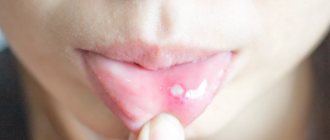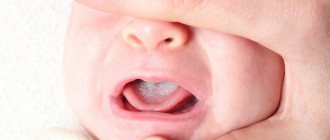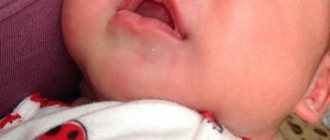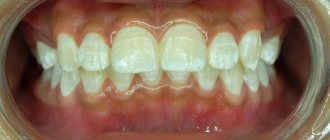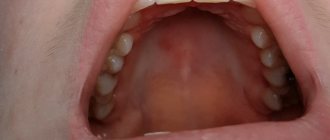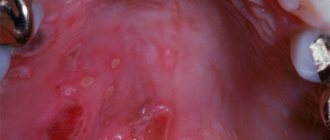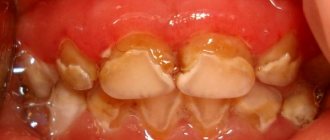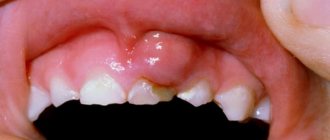All parents are attentive to their children, especially babies.
If white spots appear on the palate of a child, adults often do not know what to do or how to treat it. Therefore, it is important to remember that any rashes and spots that appear on the mucous membrane should be accompanied by a trip to the doctor. These spots are not always harmless; they can be a consequence of serious diseases. A small organism is not able to fight this on its own, so the doctor must conduct an examination, diagnose and prescribe treatment. The causes of plaque in a child can be different. This can be either candidal stomatitis or tonsillitis. These diseases are considered normal, and a baby with a strong immune system can easily overcome them. White spots on the palate of a child can last up to several months, depending on the strength of the body's immune system.
With angina, the following symptoms will be observed: lethargy, anxiety, the child becomes capricious. Stomatitis can occur due to poor oral hygiene or lack of calcium in breast milk.
Reasons for appearance
Opportunistic bacteria are part of the oral microflora of every person. Age doesn't matter here. Thrush appears when fungi, like yeast, become active and exceed the permissible number. Also, pathology is formed when pathogenic strains enter the patient’s body. The reason that leads to problems may be internal. Also, negative environmental factors influence deterioration of health. Often, anomalies are caused by non-compliance with hygiene rules, intestinal problems and others.
To prevent serious complications, you should consult a doctor promptly. A dental clinic that has modern equipment and uses the latest technologies will help you understand the problem and eliminate it. Advances in dentistry allow you to achieve results quickly. Having identified the true cause of the problem, the dentist will draw up a treatment plan. The problem will be solved when the provoking factor is eliminated.
Candidiasis in the oral cavity
This inflammatory disease is often diagnosed in children. It can affect a newborn. The basis of the disease is pathogenic fungi. They provoke damage to the mucous layer, and the uvula suffers. Candidiasis is suppressed by the defenses of a healthy toddler. But when fungi multiply quickly, the immune system cannot cope with them, as it weakens. The pathology progresses against the background of the following problems:
- Inflammatory processes in internal organs;
- Colds;
- Hormonal instability;
- Problems with the gastrointestinal tract;
- Long-term treatment with antibiotics;
Children's fragile immunity cannot withstand negativity. All this leads to imbalance. White palate in a baby’s mouth can appear due to severe stress, which reduces the body’s immune strength. The growth of fungi is provoked by excessive dryness of the mucous membranes and an imbalance of acid balance. The first sign of damage to the mucous membrane is itching. At risk are those guys who wear braces, are treated with hormonal drugs, and do not clean their chewing organs well. The disease develops especially quickly when unfavorable factors are combined. The baby's mucous membrane is covered with a cheesy film. Whitish crumbs are difficult to remove; ulcers form underneath them. They may bleed.
Infectious lesions
When the body's resistance decreases, the appearance of pathogenic bacteria is often associated with the appearance of one or another infection. As a result, white spots develop on the palate.
- Fungal strains are highly infectious. Pathogenic microbes quickly colonize the damaged mucosa.
- With scarlet fever, the baby's mouth turns red, a rash appears, and the temperature rises.
- With diphtheria, the film has dirty inclusions.
- With whooping cough, a putrid odor from the mouth is clearly heard.
- With dysentery, the layer is dense, and erosions appear underneath it.
Oral diseases
Oral problems cannot be ignored. Parents should immediately show the toddler to the pediatrician, who will refer the child to the dentist. Pediatric dentistry is a department where the exact cause of the disease is determined and a treatment regimen is developed. Specialists know how to work even with the smallest children. Problems in infants can develop due to dental diseases. Most of them are characterized by inflammation, swelling, the appearance of a film and ulcers. The source of infection is pathogenic bacteria. The main diseases include:
- Stomatitis, in which whitish sores with clearly defined edges appear. Children experience discomfort and refuse to eat. The disease progresses when the mucous membrane is damaged, there are not enough vitamins, allergies develop, and the body's defenses decrease.
- Gingivitis, when the gums and other soft tissues of the mouth are affected.
- Caries, with the active development of which white matter is diagnosed in the oral cavity in large quantities.
Stomach and intestinal problems
In pediatric practice, white spots on the palate of a child are quite common. The provoking factor is diseases of the digestive tract:
- Gastritis, which is characterized by inflammatory processes of the gastric mucosa. In addition to whitish deposits, patients experience pain, spasms, and stool disturbances.
- Dysbacteriosis, which is manifested by bloating, weight loss, problems with stool.
- Enterocolitis, in which, in addition to a film in the oral cavity, accumulation of gases and spasms of the gastrointestinal tract are diagnosed.
Causes and mechanisms
The body of a newborn has many structural and functional features and differences, and some persist into older age. Therefore, when you see white formations on the oral mucosa, you should not immediately think about pathology. There are a number of conditions that do not cause concern:
- Bon's knots.
- "Pearls" by Epstein.
- Gingival cysts.
- Neonatal teeth.
Three of the described phenomena (except the last one) make up, perhaps, the majority of cases when parents complain to pediatricians about whitish spots or dots in the mouth of a newborn. However, children may also be susceptible to pathological changes:
- Thrush (candidiasis).
- Aphthous stomatitis.
- Measles.
Based on the variety of possible factors, you will have to exclude them all. And in differential diagnosis you can’t do without a specialist. Most likely, there is no danger in white spots, but parents need to be completely sure that there is no pathology.
The causes of whitish spots or spots on the mucous membrane can be both physiological and pathological changes. Therefore, they cannot be ignored.
Diagnostics
If a baby has a white spot in the mouth, to make an accurate diagnosis, a number of tests are prescribed, as well as certain procedures. Usually the doctor immediately notices the problem when examining the surface of the mucous membrane. In addition, the following may be additionally prescribed:
- Scrapings or smears from the cheesy film;
- Collecting anamnesis during a conversation with parents;
- Clinical blood test;
Purpose of the study: detection and confirmation of Candida fungi. If necessary, the mother must additionally show the child to specialized doctors. This will help identify the inflammatory processes that occur in the internal organs, which will help prevent serious complications. An oral smear plays an important role in making a correct diagnosis. After drying the applied scraping onto medical glass, staining and examination under a microscope are carried out. Identification of fungal colonies allows the doctor to select the desired therapeutic regimen, taking into account the characteristics of the body and the age of the patient.
Additional diagnostics
Auxiliary methods are necessary in cases where clinical signs are not enough to establish the exact nature of the pathology. The range of necessary procedures may include:
- Complete blood count (leukocytes, ESR).
- Biochemical indicators (antibodies to infections).
- Serological tests.
- Smear with microscopy and culture.
After receiving the results of research and consultations with related specialists (dentist, infectious disease specialist), a final diagnosis is established. If we are talking about pathology, then the next stage of medical care will be therapeutic correction. But in each case it has an individual character, which is determined only by the doctor.
Treatment of white plaque on the palate of a child
The white spots will disappear if the cause of the problem is eliminated. If you regurgitate frequently, for example, you should change your feeding method and sterilize your utensils. A small area of fungal infection is treated with topical preparations. Severe forms of the disease are treated medicinally using complex drugs. Fungal diseases are dealt with:
- Clotrimazole;
- Candide;
- Pimafucin;
- Fluconazole;
- Diflucan;
A sterile gauze ball is moistened with the solution. They gently wipe the oral cavity several times a day. The duration of therapy depends on the complexity of the situation. Treatment usually lasts 7-10 days. Irrigation or lubrication is also prescribed. To boost the body’s defenses, doctors recommend vitamin complexes and probiotics for children. This will restore the natural microflora in the intestines.
Prevention
Everyone who gives birth should know how important hygienic cleaning of the child’s oral cavity is. This procedure cannot be ignored. It can prevent many dental diseases. Therefore, do not miss visits to the dentist! Only a doctor can notice problems at an early stage. Treatment started on time will be faster and easier.
Compliance with preventive measures minimizes the risk of pathology. During the period of bearing a child, the expectant mother needs to take care of her health, pay close attention to oral hygiene procedures, and not introduce into the diet those foods that create a favorable atmosphere for the activation of fungi. Prevents problems:
- Refusal of artificial feeding, transition to breastfeeding;
- Before feeding the baby, the breasts should be treated with a solution of baking soda;
- Pacifiers, pacifiers, and bottles should be sterilized;
- After the baby has eaten, you need to give him boiled warm water to drink, which will wash away the remaining milk from the mucous membrane.
The most common causes of white spots on the palate of a child
Cyst
- Bon's knots. They are located on the mucous membrane of the mouth and appear in the form of a cyst and have a round shape. These spots are harmless, are not accompanied by pain and do not cause discomfort to the baby. They dissolve on their own over time and do not pose a threat to health.
- "Epstein's Pearls" These are lump-shaped cysts that form from epithelial tissue. They do not negatively affect the baby's body.
Stomatitis
- Candidal stomatitis. It is a plaque that envelops not only the palate, but also the cheeks. The name of this stomatitis comes from the fungus Candida, which infects the mucous membrane. In this case, the white spots look like a thick curd coating. If you try to remove it, you will notice that the mucous membrane is strewn with inflammatory foci, which gradually develop into erosion.
- Aphthous stomatitis. This species is characterized by white spots, which are surrounded by a red rim. They are accompanied by unpleasant sensations and can be caused by: the gastrointestinal tract, viruses and bacterial infections, as well as allergic reactions. Such rashes require careful attention and treatment, as they can develop into severe ulcers.
- Herpes. With this disease, the mucous surface of the mouth is strewn with small transparent rashes that seem to merge with each other. Such rashes are difficult to treat. The cause may be decreased immunity. In this case, herpes is activated, since these conditions are quite favorable for it.
The causes of a rash in a child’s mouth can be not only stomatitis and cysts, but also infectious pathologies. A child who has had chickenpox or diphtheria has a weak immune system, so he can become infected with a virus that can cause rashes in the mouth. But the most common cause of rashes is sore throat; it appears due to streptococcal and staphylococcal bacteria.
